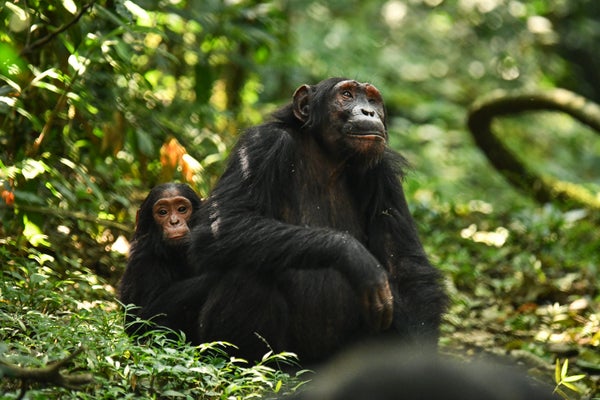An hour’s drive down a ragged dirt road, deep in the heart of Uganda’s Kibale National Park, a small research camp sits in the middle of chimpanzee territory. Tangled vines drape ancient trees in the forest, and equatorial sunsets ignite the sky, savannas, lakes and misty mountain peaks in molten gold and ember red. For the primatologists stationed here, mornings begin with a map of yesterday’s chimp movements, a tally of fruiting trees and an ear tuned to the forest. The apes’ calls start early with low, rolling “pant-hoots” that ripple through the canopy. On some days the chimps are close by. On others the scientists search for them for hours, winding through the Ngogo chimpanzee community’s home range of 35 square kilometers (an area more than half the size of Manhattan) along a grid of well-worn trails.
On one such morning in 2019 a few researchers spotted something curious: Lindsay, a chimpanzee around two years old, reached forward from her mother Beryl’s back to cover the older chimp’s only functioning eye. At first it seemed like a fleeting moment of play. But the scientists later learned that Beryl, who moved attentively through the undergrowth with occasional pauses, responded to her daughter the same way every time: by stepping forward. Within a few years the gesture seemed to become an intentional “let’s get moving!” signal between the two.
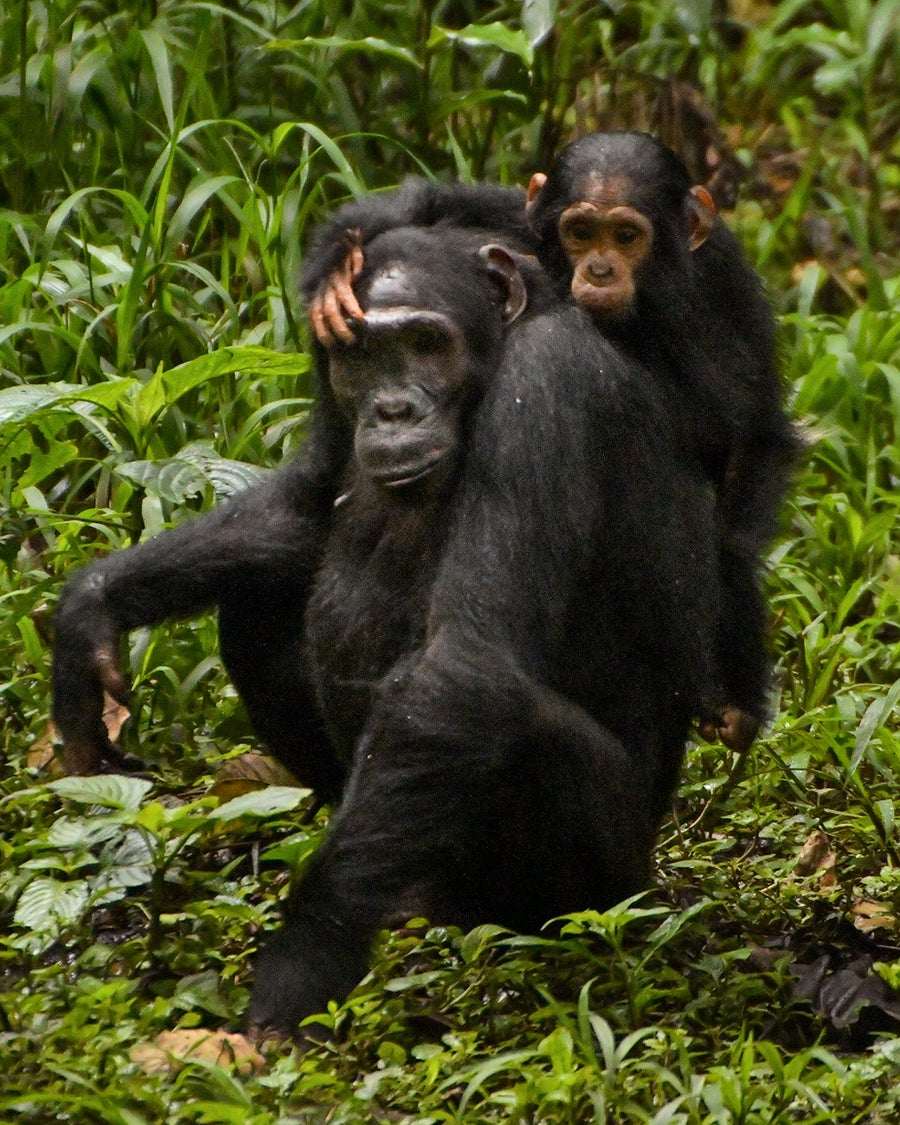
Beryl and Lindsay perform their “hand-on-eye” gesture.
Kevin C. Lee
On supporting science journalism
If you're enjoying this article, consider supporting our award-winning journalism by subscribing. By purchasing a subscription you are helping to ensure the future of impactful stories about the discoveries and ideas shaping our world today.
What might have started as Lindsay’s simple, spontaneous attempt to get her mother’s attention—by blocking Beryl’s already limited vision—over time took on a shared meaning akin to a secret handshake or inside joke. Among the Ngogo chimpanzees, researchers are coming to realize that such behaviors are not random quirks but part of a growing picture of how apes develop and transmit culture.
“This is fascinating from a [scientific] literature perspective because there had been no prior record of this gesture,” says primatologist Bas van Boekholt, now at the University of Zurich, who led a study published recently in Animal Cognition to decipher the gesture’s meaning. In 2022, during his second field season at Ngogo, van Boekholt was reviewing video footage from his field assistant when he first noticed Lindsay’s hand-on-eye behavior. Among nonhuman primates, previous examples of gestures that were unique to particular individuals had been documented only in captive environments, he says. “We haven’t had convincing evidence that they occur in the wild,” van Boekholt adds.
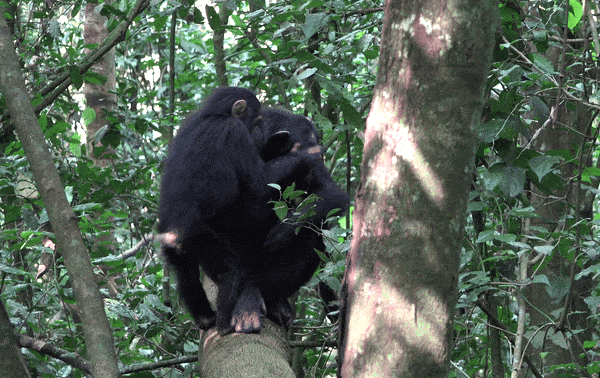
Lindsay covers Beryl’s eye.
Bas van Boekholt
Curious about whether others had observed Lindsay making the same gesture, van Boekholt reached out to fellow researchers and field assistants. Isabelle Clark, a biological anthropologist at the University of Texas at Austin, recalled being among those who had spotted the behavior as early as 2019. “This is a big deal because this gesture isn’t part of the common chimp repertoire. It’s not in our chimp gesture dictionary, so to speak,” she explains. “It’s a rare and compelling example of how gestures might be learned rather than hardwired. I’m sure there are subtle, unrecorded ones between closely bonded individuals, but this one stood out; it was so striking and even a little funny.”
To investigate further, researchers from various field seasons conducted a collaborative quantitative analysis of 179 videos of Lindsay and Beryl that included 21 instances in which Lindsay used the gesture. Young chimps are known to be playful while riding on their mother’s back, and the scientists scrutinized Lindsay’s behavior: Was she simply brushing her mother’s eye coincidentally? The data suggested otherwise.
Van Boekholt’s team also reviewed more than 1,020 video clips of 12 other mother-child pairs within the Ngogo chimpanzee community and found only three isolated instances in which other chimps performed the gesture. In each of those cases, the movement was made just once, without the same intentionality markers present in Lindsay and Beryl’s interactions.
“Infants do play around on their mothers’ backs and sometimes touch their mothers’ eyes, but it’s different; there’s no clear intent or consistent outcome,” van Boekholt says. “Maybe if we analyzed another 1,200 clips, we’d find more cases, but at this point, we feel confident in saying this is an idiosyncratic gesture.”
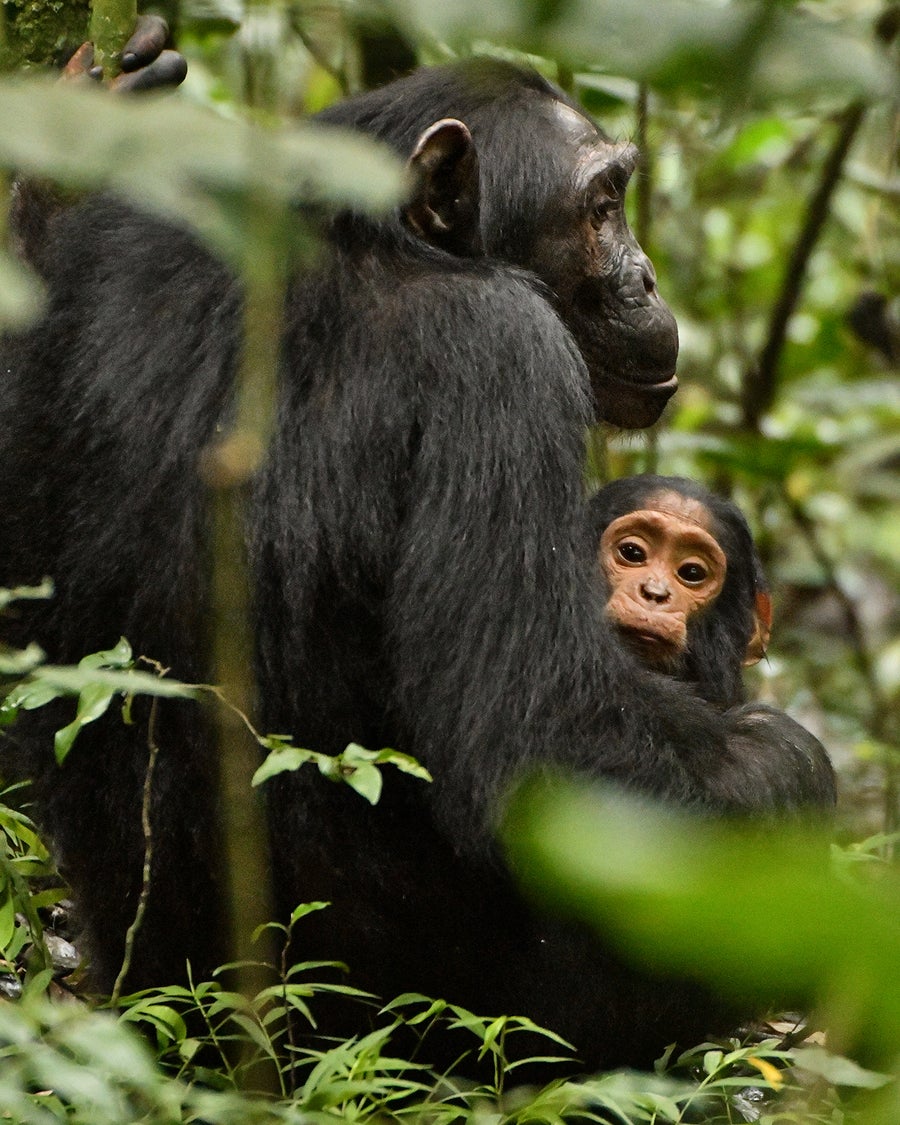
Lindsay and Beryl in 2019.
Kevin C. Lee
Clark, who specializes in social behavior development in juvenile and adolescent chimpanzees, says that chimps exhibit foundational elements of symbolic communication—the ability that lets humans create limitless symbols for different meanings—and that gestures similar to Lindsay’s could be the building blocks of eventual humanlike communication.
“There are multiple theories on how gestures develop in primates, particularly great apes,” van Boekholt says. “Tracking their development over a lifetime offers clues about the evolution of language and communication.”
The researchers note that if the hand-on-eye gesture exists in other chimpanzee communities, it probably carries a different meaning there. Cat Hobaiter, a primatologist and field scientist at the University of St. Andrews in Scotland, who was not involved in the study, cautions against drawing broad conclusions from a single chimpanzee group. “It’s like trying to describe human civilization after only visiting Paris, Shanghai, and Auckland,” she says. Just as customs and traditions differ across human cultures, gestures among chimpanzees can vary widely; a signal of reassurance in one group might mean something entirely different, or nothing at all, in another.
For instance, the long-recognized and well-documented gesture of leaf clipping—in which a chimpanzee tears a leaf with its teeth—varies in meaning across chimp communities. In some groups, leaf clipping’s distinctive sound serves as a mating call, while in others, it signals frustration or an alpha male’s display of dominance.
Ape communication researchers have long debated whether gestures and signals such as these are innate or learned through social context and experience. Many scientists now recognize that while gestures may have biological roots, their meanings are shaped by social and environmental dynamics.
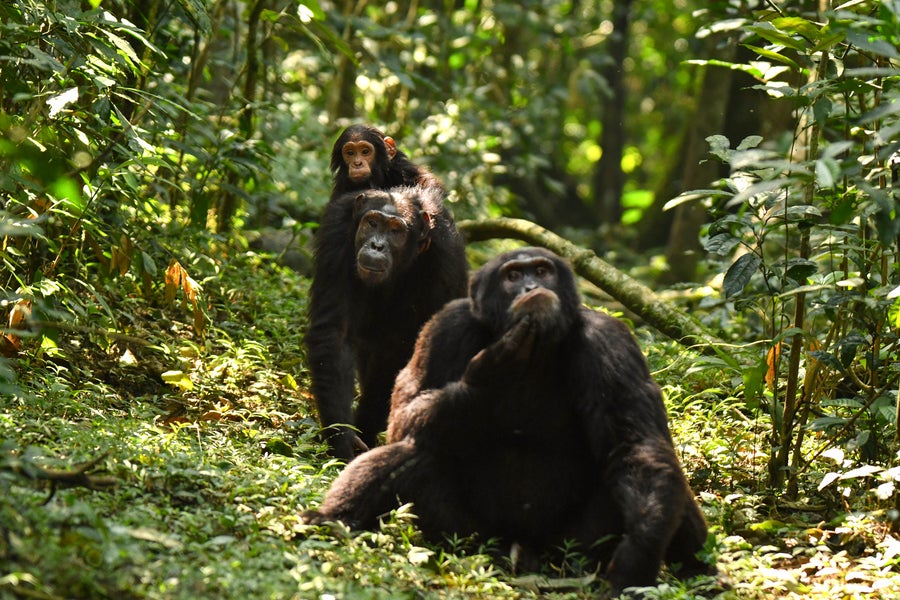
Beryl and Lindsay on the move.
Kevin C. Lee
The development of Lindsay’s gesture, Hobaiter says, suggests that apes—like humans—have the capacity to form particular shared uses of a signal, regardless of whether they’re created from scratch. She cautions against overemphasizing uniqueness at the expense of a broader insight: the more we observe ape cultures, the more depth we see in them. Chimpanzees and bonobos share nearly 99 percent of their DNA with humans. And their traditions, social learning and communication reveal a continuum rather than a sharp divide between us and other great apes.
Van Boekholt has returned to Uganda, where he is once again studying the mother-daughter duo. Lindsay, who is old enough to walk independently, still clings to her mother—and continues to use the gesture. Van Boekholt suspects Beryl may be pregnant, and he is eager to see whether Lindsay’s potential future sibling will adopt the gesture and thus turn it into a family tradition. If social learning plays a role, he notes, the gesture is likely to persist. “Any parent of a newborn understands the private language they share with their child—meanings that others would never recognize. Now we’re seeing a similar phenomenon unfold in the wild,” he explains. For Lindsay, “logically, blocking her mother’s vision seems counterintuitive, the last thing she’d want to do. Yet, for some reason, [Lindsay and Beryl have] created this shared meaning between them, and I think that’s just really wonderful.”
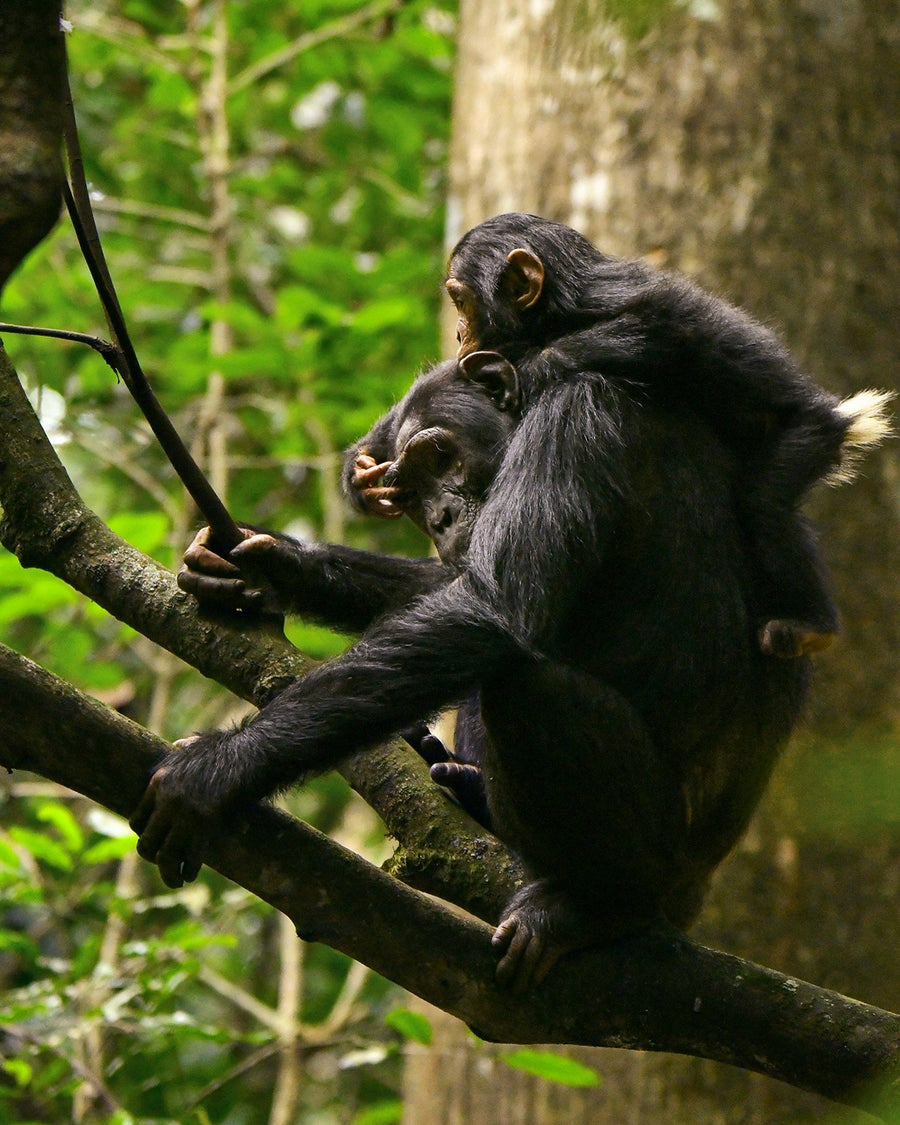
Lindsay covers Beryl’s eye.
Kevin C. Lee
A version of this article entitled “Mother-Daughter Signal” was adapted for inclusion in the June 2025 issue of Scientific American. This text reflects that version, with the addition of some material that was abridged for print.
